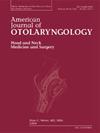Association of nasal surgery with olfactory function among older adults
IF 1.7
4区 医学
Q2 OTORHINOLARYNGOLOGY
引用次数: 0
Abstract
Background/purpose
Olfactory Dysfunction (OD) is a prevalent condition that commonly presents in the older adult population. Various factors have been shown to contribute to OD, such as neurodegenerative disease, older age, and smoking status; however, the influence of nasal surgery on olfactory function is not well delineated. This study seeks to explore the potential effect of nose surgery on olfactory function.
Methods
This cross-sectional study was conducted on data for 2285 adults from Round 1 of the National Social Life, Health, and Aging Project (NSHAP), a nationally representative sample of US older adults. The 5-item Sniffin’ Sticks test was used to define olfactory function: correctly identifying 4 odors indicated normal olfactory function, while correctly identifying 0–3 odors was considered OD Associations between prior nasal surgery and OD were assessed using multivariable logistic regression, and adjusted odds ratios (OR) were calculated. Analyses were weighted using NSHAP-provided person-level weights to account for sampling design.
Results
OD was present in 18.4 % of adults. The weighted average age was 67.1 ± 7.2 years among those with normal olfaction and 70.9 ± 7.9 years for those with OD. Of adults with OD, 9.8 % had a prior nasal surgery as compared to 8.1 % of those with normal olfaction, although the difference was not statistically significant. After adjusting for age, gender, race, education, prior stroke, dementia, and self-reported mental health, prior nasal surgery was not significantly associated with OD (OR: 1.14; 95 % CI: 0.77–1.70).
Conclusion
Prior nasal surgery was not associated with OD after controlling for covariates. While this study does provide unique insight into the relationship between nasal surgery and OD in nationally representative cohort of older adults, it was limited since the dataset utilized did not contain information on the specific surgery that participants underwent. Therefore, further research with more detailed information on the types of nasal surgeries and sinonasal conditions prior to surgery would further help elucidate the relationship between and nasal surgery and OD.
老年人鼻手术与嗅觉功能的关系
背景/目的嗅觉功能障碍(OD)是老年人普遍存在的一种疾病。各种因素已被证明会导致吸毒过量,如神经退行性疾病、老年和吸烟状况;然而,鼻部手术对嗅觉功能的影响并没有很好的描述。本研究旨在探讨鼻手术对嗅觉功能的潜在影响。方法本横断面研究是对2285名成年人的数据进行的,这些成年人来自全国社会生活、健康和老龄化项目(NSHAP)的第一轮,这是美国老年人的全国代表性样本。采用5项嗅探棒试验来定义嗅觉功能:正确识别≥4种气味为嗅觉功能正常,正确识别0-3种气味为嗅觉功能异常,使用多变量logistic回归评估既往鼻手术与嗅觉异常之间的相关性,并计算调整后的比值比(OR)。分析使用nshap提供的个人层面的权重来考虑抽样设计。结果18.4%的成人血清中存在sod。嗅觉正常者的加权平均年龄为67.1±7.2岁,嗅觉过度者的加权平均年龄为70.9±7.9岁。在嗅觉异常的成年人中,9.8%的人之前做过鼻手术,而嗅觉正常的成年人中这一比例为8.1%,尽管差异没有统计学意义。在调整了年龄、性别、种族、教育程度、既往卒中、痴呆和自我报告的心理健康等因素后,既往鼻部手术与OD无显著相关(OR: 1.14;95% ci: 0.77-1.70)。结论控制协变量后,既往鼻部手术与OD无关。虽然这项研究确实为全国具有代表性的老年人队列中鼻腔手术与OD之间的关系提供了独特的见解,但由于所使用的数据集不包含参与者接受的特定手术的信息,因此它是有限的。因此,进一步研究更详细的鼻部手术类型和术前鼻部状况,将有助于进一步阐明鼻部手术与OD的关系。
本文章由计算机程序翻译,如有差异,请以英文原文为准。
求助全文
约1分钟内获得全文
求助全文
来源期刊

American Journal of Otolaryngology
医学-耳鼻喉科学
CiteScore
4.40
自引率
4.00%
发文量
378
审稿时长
41 days
期刊介绍:
Be fully informed about developments in otology, neurotology, audiology, rhinology, allergy, laryngology, speech science, bronchoesophagology, facial plastic surgery, and head and neck surgery. Featured sections include original contributions, grand rounds, current reviews, case reports and socioeconomics.
 求助内容:
求助内容: 应助结果提醒方式:
应助结果提醒方式:


